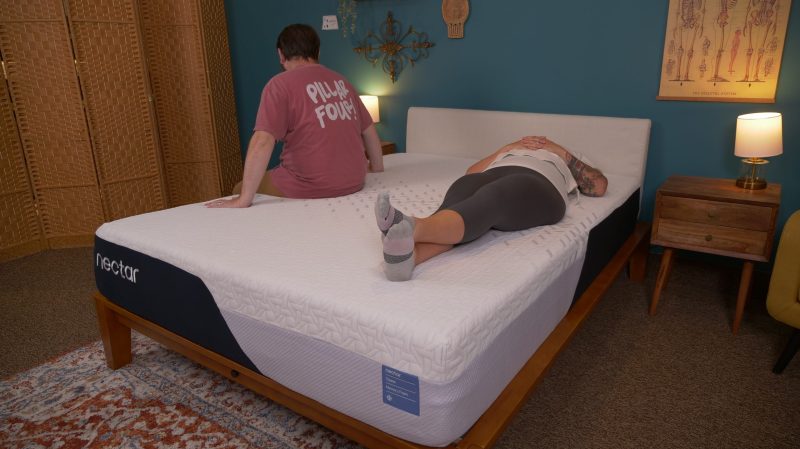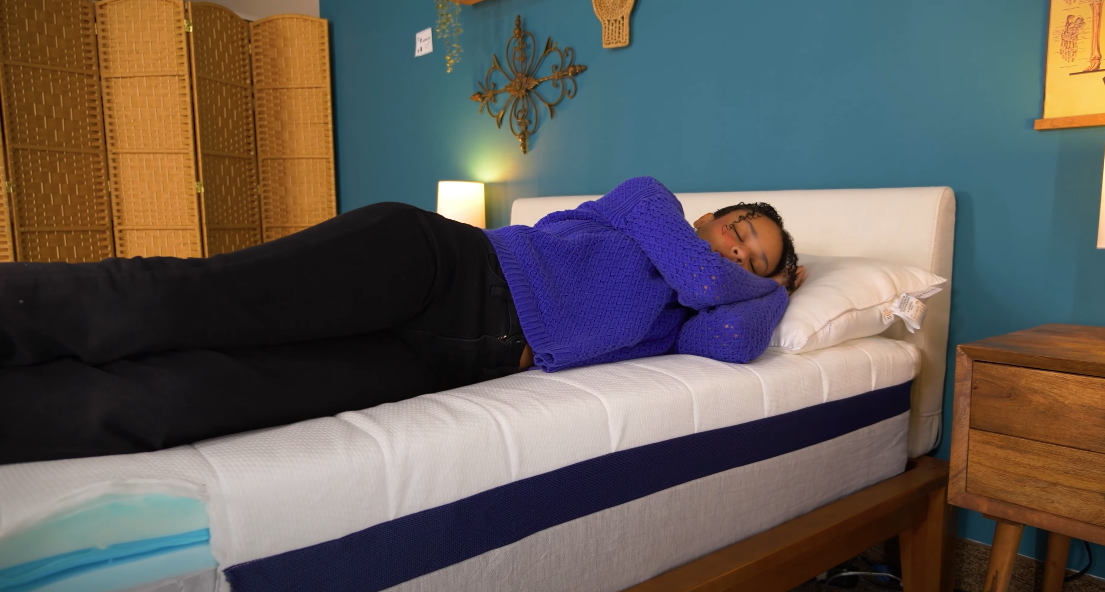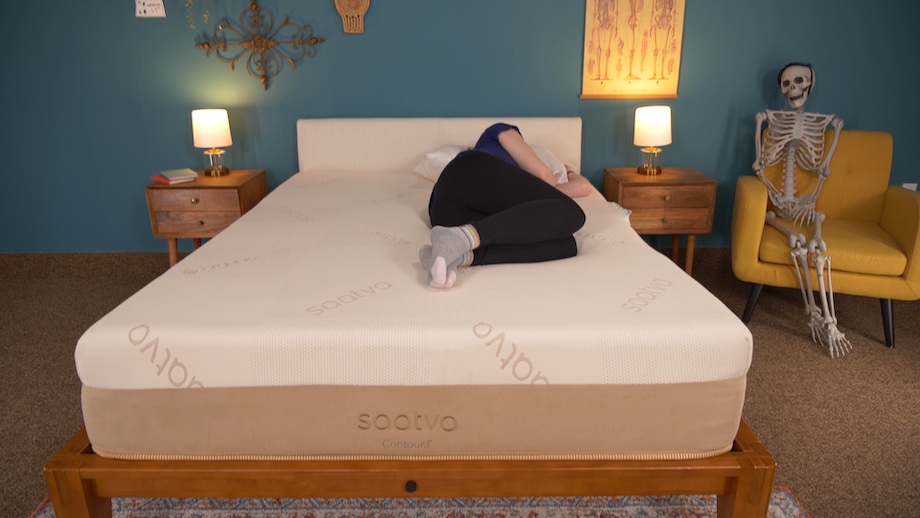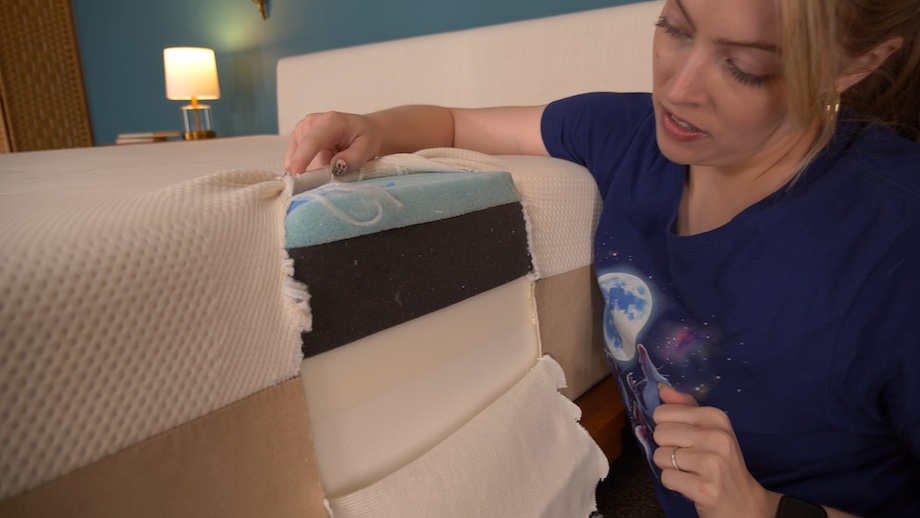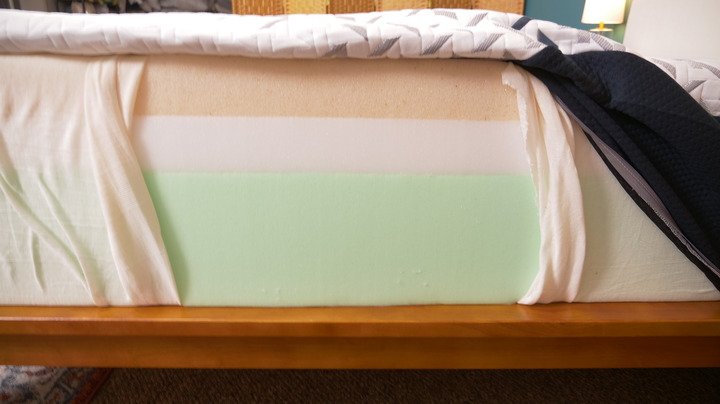Many people love the contouring powers of memory foam. This material can feel like a soothing, cradling hug when you lie down in bed, and it’s adept at taking pressure off your sensitive joints. It can also keep you supported with a strong core.
The best memory foam mattress will combine the above benefits with features tailored to your individual sleep needs, whether you require a bed that stays comfortably cool or foam that responds well to a certain sleeping position.
Utilizing our extensive experience in the sleep industry, we’ve compiled a list of our favorite memory foam mattresses. Consider your sleep style and browse the beds below to find your memory foam match.
The best memory foam mattress is…
We picked the Nectar mattress as the top foam bed because of its versatile feel, pressure-relieving layers, and affordable price range.
Best Memory Foam Mattresses
- Nectar – Editor’s Pick
- Helix Midnight – Best Hybrid Memory Foam Mattress
- GravityLux by WinkBeds – Best Soft Memory Foam Mattress
- Nolah Signature – Best Memory Foam Mattress for Side Sleepers
- Contour5 – Best Memory Foam Mattress for Back Pain
- Cocoon Chill Memory Foam – Best 10-Inch Memory Foam Mattress
- Nectar Luxe – Best Cooling Memory Foam Mattress
- Bear Original – Best Firm Memory Foam Mattress
- Plank Firm – Best Memory Foam Mattress for a Heavy Person
My Video Review of The Best Memory Foam Mattresses

Compare The Best Memory Foam Mattresses
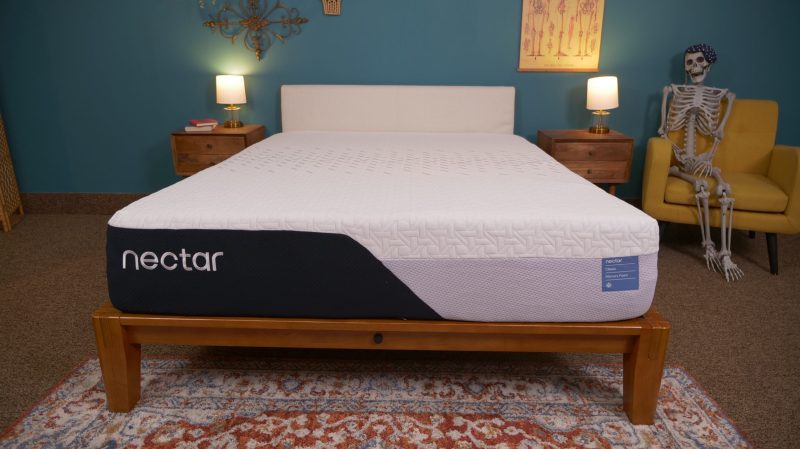
|

|

|

|

|

|
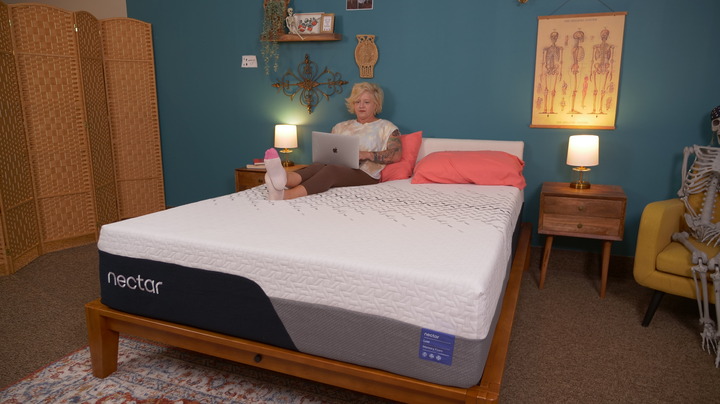
|

|

|
|
| Nectar Mattress | Helix Midnight Mattress | WinkBeds GravityLux Mattress | Nolah Signature 12″ Mattress | Contour5 | Cocoon Chill Mattress | Nectar Luxe Mattress | Bear Original Mattress | Brooklyn Bedding Plank Firm Mattress | |
| Rating | |||||||||
| Firmness | Firm: 7.5/10 | Medium-firm: 6/10 | Medium-firm: 6/10 | Medium-firm: 6/10 | Medium: 5/10 | Medium-firm: 6/10 | Medium: 5.5/10 | Firm: 7/10 | Multiple firmness options |
| Material | Foam | Hybrid | Foam | Foam | Foam | Foam | Foam | Foam | Foam |
| Cooling | — | — | — | — | — | ||||
| Warranty | Lifetime warranty | 10-year warranty | Lifetime warranty | Lifetime warranty | Lifetime | 10-year warranty | Lifetime | Lifetime warranty | 10-year warranty |
| Shipping | Free shipping | Free shipping | Free shipping | Free shipping | Free shipping | Free shipping | Free shipping | Free shipping | Free shipping |
| Trial Period | 365 nights | 100 nights | 120 nights | 120 nights | 365 nights | 100 nights | 365 nights | 120 nights | 120 nights |
| Best For | Back Sleepers, Back Pain, Stomach Sleepers, Side Sleepers, Couples | Couples, Back Sleepers, Side Sleepers | Back Sleepers, Hot Sleepers | Side Sleepers, Back Pain | Back Pain, Couples, Back Sleepers | Back Sleepers, Hot Sleepers, Side Sleepers | Side Sleepers, Back Sleepers, Hot Sleepers | Hot Sleepers, Back Sleepers, Side Sleepers, Hip Pain | Stomach Sleepers, Back Pain, Seniors |
How We Test Memory Foam Mattresses
At Sleep Advisor, our mattress reviews are based on findings from in-person tests that allow us to have a genuine understanding of how the mattress feels and performs.
Our diverse cast of testers features people with different body types, preferences, and overall experiences–so we can gain an in-depth, unbiased evaluation that represents a variety of sleepers. We test each mattress in every sleeping position and in a variety of categories to ensure we cover all the bases. Read more about our product testing process here.
When it comes to memory foam mattresses, we worked to determine the most important factors to consider. More on that below.

What We Want to See in the Best Memory Foam Mattress
Strong Support Core
Memory foam mattresses are known for providing a delectable sink and cradling your body, but it’s important that this cushioning effect is backed up by strong support underneath. We made sure each bed earned at least a 4/5 in the support category to ensure they go above and beyond the average foam bed.
Good Pressure Relief
Foam beds are also known for relieving pressure buildup. This can be useful for pain relief in sensitive areas like the back or joints. You don’t want a too-dense slab of memory foam that keeps you from achieving a comfortable sink.
Quality Materials
Not all foam mattresses are created equal. Even for budget options, you want to be sure the foams used are durable and effective. We made sure to pick foam beds we believe are built for support and built to last.
The Best Memory Foam Mattresses, Reviewed
Nectar – Editor’s Pick
The Advisor Says: We believe that Nectar offers a quality bed backed up by generous policies, and for under $1,000 for a queen (after discounts). If you’re looking for a firmer foam mattress on a budget, the Nectar Classic has you covered.
Why the Nectar Earned Best Memory Foam Mattress Overall
The Nectar takes all the traits I love about traditional memory foam—oodles of pressure relief plus a hug-like feeling—and bundles them into a modern, consumer-friendly mattress. It’s one of the most recognizable beds you can order online, and I’ve tested it repeatedly to make sure it deserves that status.
Now, no bed is perfect, but if you dig memory foam, the Nectar should be one of your first considerations. It balances that signature sinking feeling up top with stellar support from the base, and its policies are some of the best I’ve encountered in my years of mattress research. For its well-rounded construction, legacy reputation, and awesome pricing, it earns the top spot on this list.
Helix Midnight – Best Hybrid Memory Foam Mattress
The Advisor Says: The Midnight has one of the most impressive score spreads of all the mattresses we’ve reviewed. The best word to describe it is “balanced”: it’s got pressure relief, support, and cooling power in spades, plus a versatile medium-firm feel that tends to satisfy lots of sleepers.
Why the Helix Midnight Earned Best Hybrid Memory Foam Mattress
If you’re a memory-foam fan but don’t want an all-foam bed, you can look for hybrid mattresses that incorporate cushy foam layers above their innerspring units. The Helix Midnight is one such bed (though it calls its proprietary version of the material Memory Plus Foam). With the Midnight, you’ll get more of an airy, springy feeling than you would from a dense foam bed. “I like how the foams feel soft, but not too soft, like I’m sinking in and getting stuck,” said Emma.
GravityLux by WinkBeds – Best Soft Memory Foam Mattress
The Advisor Says: We think the GravityLux is a great option if you’re looking for a well-rounded bed with that iconic foam feel. We gave it high marks for pressure relief, motion isolation, support, and cooling!
Why the GravityLux Earned Best Soft Memory Foam Mattress
The GravityLux comes in three possible firmnesses: Soft, Medium, and Firm. The Soft version should feel pleasingly plush to side and back sleepers, as well as folks who switch between the two positions. Its secret? A proprietary kind of memory foam called AirCell™ Memory Foam, which eschews the traditional viscoelastic materials for a new kind of construction that features “capsules” of air. These air pockets lend it all the pressure-relieving properties of classic memory foam, but without disadvantages such as heat retention.
Nolah Signature – Best Memory Foam Mattress for Side Sleepers
The Advisor Says: We recommend the Nolah Signature for sleepers looking for a foam bed that has a soft but accommodating firmness. It also runs cooler than most foam beds, and has enough pressure relief to cradle sensitive joints.
Why the Nolah Signature Earned Best Memory Foam Mattress for Side Sleepers
Memory foam has long been the go-to material when it comes to pressure relief, but Nolah claims that their proprietary AirFoam™ blows older versions of memory foam out of the water. According to the brand, AirFoam™ provides up to four times the pressure relief you can get from traditional memory foam. Several of my team members tested the Nolah Signature to see just how well-suited to side sleepers it was. The results were pretty unanimous, and summed up by my fellow tester Liz: “This mattress is perfect for sleeping on your side.”
Contour5 – Best Memory Foam Mattress for Back Pain
The Advisor Says: The Contour5 is Saatva’s newest all-foam bed, and it lives up to all our expectations. If you’re searching for cushy softness with a luxury feel (and generous policies to back it up), look no further.
Why the Contour5 Earned Best Memory Foam Mattress for Back Pain
The Contour5 is Saatva’s super-soft all-foam mattress. Despite that, it’s a great option for back pain, as it offers support and alignment alongside its pressure-relieving capability. It has a whopping five different specialized foam layers. Each is geared toward lumbar support (with a firmer feel in the center of the mattress) and cooling (from aerated foams and channels for excess heat to escape).
Cocoon Chill Memory Foam – Best 10-Inch Memory Foam Mattress
The Advisor Says: We love the Cocoon Chill for hot sleepers who are set on buying a foam bed. Its medium-firm profile should work for the majority of sleepers, and its perfect motion isolation score should appeal to couples who toss and turn.
Why the Cocoon Chill Earned Best 10-Inch Memory Foam Mattress
If you want a memory foam mattress with a manageable 10-inch height, the Cocoon Chill not only fits the bill—it also boasts some extra-cool features. Its cover, for example, is augmented with phase change material, which helps to carry heat away from your body while ensuring that temperature changes don’t affect the surface of the bed.
Nectar Luxe Memory Foam – Best Cooling Memory Foam Mattress
The Advisor Says: The Nectar Luxe is Nectar’s new and improved luxury mattress model. It brings the iconic slow-moving memory foam feel with some added cooling benefits not usually seen in these types of beds. We recommend it for anyone looking for a softer, pressure-relieving foam mattress.
Why the Nectar Luxe Earned Best Cooling Memory Foam Mattress
Memory foam is not often known for its cooling capability; in fact, it tends to trap heat. Thankfully, there are innovations for hot sleepers who don’t want to miss out on this material’s cushiness. The Nectar Luxe features a cover made with cooling fibers that bring down the temperature of this mattress—all while you reap the benefits of its soft surface. During testing, we thought it was cool to the touch.
Bear Original – Best Firm Memory Foam Mattress
The Advisor Says: With a name that inspires hibernation, it’s no surprise we found the Bear Original to be an attractive all-foam mattress at its fair price. It’s got a firmer feel that’s sure to please folks looking for support—and a surprising amount of bounce.
Why the Bear Original Earned Best Firm Memory Foam Mattress
Many people think of memory foam as a soft, malleable material that will sink easily beneath your weight. But foams can be made in different densities and with different feels, and a firm memory foam mattress isn’t just possible—it’s often preferable, especially if you sleep on your back or stomach. After testing the Bear Original, we concluded it fit the bill: “I did really like this bed when I laid on my back, and when I laid on my stomach. It was firm enough for those two positions,” said Mark.
Plank Firm – Best Memory Foam Mattress for a Heavy Person
The Advisor Says: We’re constantly calling this mattress one of the firmest in the online market, and if you don’t believe us, try it for yourself! It offers both a classic firm and extra-firm feel in its flippable design, alongside posture-aligning support. Bonus points for good marks in performance for cooling, bounce, and couples.
Why the Plank Firm Earned Best Memory Foam Mattress for a Heavy Person
The Plank Firm was inspired by the mat-like sleeping surfaces found in multiple regions of Asia, and it’s an affordable way to obtain the robust support that plus-sized sleepers need. It’s flippable, too, so you’re able to access two firmness levels instead of one. It doesn’t use traditional memory foam, but has an all-foam construction nonetheless, with a weight capacity of up to 950 pounds.
Other Memory Foam Mattresses We Tested
While these mattresses didn’t make our list, each of these beds are great fits for memory foam lovers. Check out our featured recommendations below.
| Purple Mattress | Layla Memory Foam Bed |
| Tempur-ADAPT Mattress | Tuft & Needle Original Mattress |
| Casper Original Mattress | Leesa Legend Mattress |
What is Memory Foam?
Memory foam is made of a plastic polymer called polyurethane, plus additional substances. These additives change from manufacturer to manufacturer, but they’re what lends the foam its signature feel and elasticity.
Memory foam is also known as viscoelastic polyurethane foam. The term “viscoelastic” refers to the fact that the foam is both viscous (it resists somewhat when pressure is applied) and elastic (it “bounces back” to its original shape when pressure is removed).¹ Viscoelastic properties are what make this foam unique — poly foam without viscoelastic properties is not memory foam.
What Does Memory Foam Feel Like?
Fans of memory foam report that it has a unique and recognizable feel. In my opinion, I’d say it’s pretty cushy. It hugs your body as you compress the mattress, providing exceptional pressure relief and support. This combination is also super helpful for those struggling with aches and pains, since it works to carefully cradle your body.
The material will change shape to match the outline of your body, meaning the mattress is essentially customized to your needs each time you lie down. As we’ve mentioned, getting up will allow the material to “bounce” back to its original position (the speed of which depends on the foam’s responsive properties).
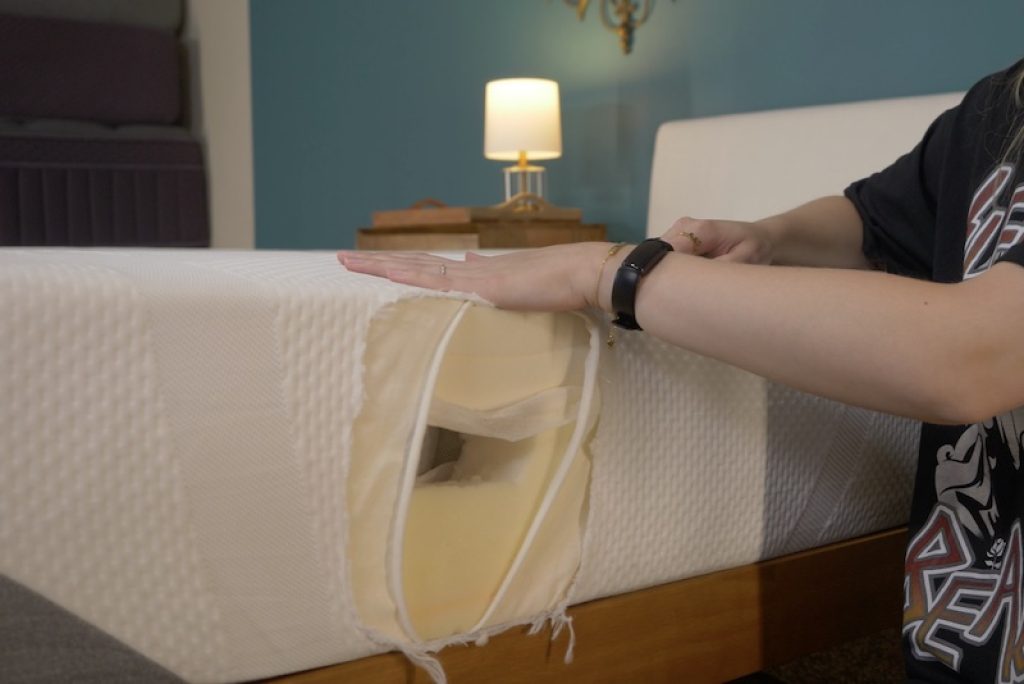
Types of Memory Foam
Memory foam is a broader category than you might expect. The composition can vary depending on how manufacturers customize it in order to enhance its properties, giving a boring ol’ foam mattress a unique edge. Click on the buttons to see the common types of memory foam you might see in a mattress:
Gel Memory Foam
Gel is infused into the memory foam, usually to help regulate temperature. It can be a standard cooling gel or infused with materials like copper (which also has antibacterial properties).
Open-Celled Memory Foam
Memory foam is generally more dense than porous, but some manufacturers use foam with larger pores, or open-celled memory foam, to keep air flowing through it.
Responsive Memory Foam
Most memory foam sinks and takes a while to bounce back. However, some manufacturers can adjust the firmness and density of the foam to make it more flexible, giving it a quicker response time.
Plant-Based Memory Foam
Eco-conscious consumers may be seeking an environmental alternative to synthetic foams. Some foams are made up of plant material, such as soy, and come with a host of unique properties and benefits.
What to Look for in a Memory Foam Mattress
There’s a lot to consider when you’re shopping for a foam mattress. We’ve outlined the categories you’ll want to keep in mind, whether it’s based on your preferences or individual sleeping needs.
Pressure Relief
Memory foam beds can usually be found in the winner’s circle when it comes to pressure relief. This slow-moving material has enhanced elasticity and viscosity that combine with your body heat and weight to gently cradle you. By molding to you, memory foam keeps pressure from building up while you’re sleeping.
Pressure relief is also important for folks who have chronic pain or conditions that cause it. A foam mattress that’s good at relieving pressure can cradle sensitive areas, lessening the possibility of discomfort.

For more, check out the best mattresses for pressure relief.
How do we test for pressure relief?
We use a pressure map to record how much pressure builds up when we lay on the mattress. We have each of our different-sized testers lay on the bed on their side and back. The pressure map is color-coded to show the degree of how much pressure has built up in each area. Blue and green means little to no pressure, whereas yellow or red indicates high pressure. Generally, we want to see maps with a lot of blue and green—ideally no red.
Support
The cushioning capability of memory foam needs to be backed up by sturdy support. In an all-foam bed, this means an effective support core. The core has to be made up of denser, firmer foams to ensure it can properly support the sleeper’s weight—but not so much that it’s uncomfortable or can be felt through the comfort layers. It’s a delicate balance.
How do we test for support?
We have our testers representing the different weight categories lay on the mattress in each position. From here, they’ll determine the amount of sinkage and how aligned their spines feel. We’ll compare our results with the mattress firmness to corroborate and explain our findings.
Durability and Quality
Durability equals longevity, which means you get more out of your mattress. When it comes to durable foam mattresses, these beds should have quality materials and construction. This means dense enough foams to support you without egregious sagging, but also reactive enough to bounce back to their original shape.
For more durable mattresses, check out the best beds that won’t sag; there are some memory foam options there, too!
Firmness and Indentation Load Deflection (ILD)
The firmness of memory foam is formally measured on a scale known as indentation load deflection (ILD), which is calculated by measuring the amount of force in pounds it takes for the material to compress. The higher the ILD, the firmer the foam will be. Very soft foams have an ILD of around 20 or less, whereas very firm ones have an ILD above 30.
We should note that ILD only measures the firmness of the memory foam layers, not the overall firmness of the mattress. At Sleep Advisor, we also use a general mattress firmness scale of 1-10 (10 being the most firm), based on how the bed feels as you lie on it. A memory foam bed can hold multiple ILD firmnesses in different layers. Generally, you want to see the firmer (higher ILD) foams near the bottom of the mattress, and softer (lower ILD) foams near the top. This ensures the bed has both support and comfort.
Consider both the ILD of the memory foam and the holistic feel of the mattress as you shop. If you’re someone who likes a very solid foundation of firm support, aim for high numbers in both categories.
Density
The density of memory foam is measured in pounds per cubic foot (PCF), and it tells you how tightly packed (vs. airy) the foam is as a material.
Higher-density foams can signal an extremely durable and supportive bed, but they can also mean the bed will retain heat more easily. Look for cooling technology when you’re considering those robust foams.
It’s important to remember that density isn’t the same thing as thickness — a layer of memory foam can be very dense without being impressively thick, and a lightweight foam can be several inches in height.
Sleeping Position
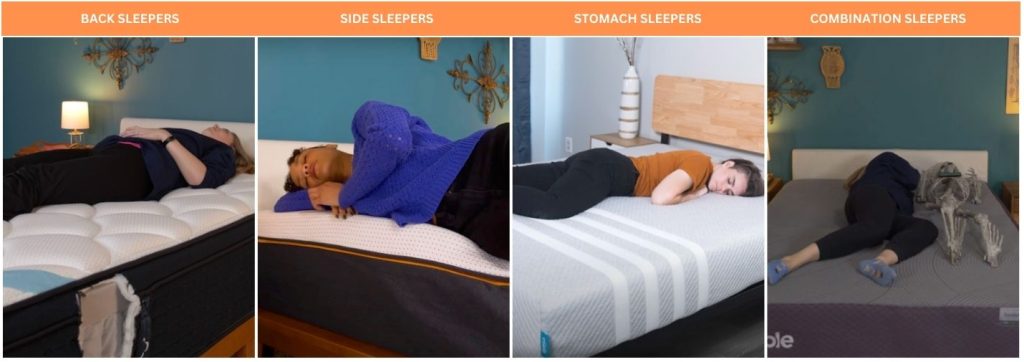
There’s no one-size-fits-all memory foam mattress, and one of the top reasons for that is your preferred sleeping position. However you sleep will require a suitable environment, and it’s important to choose a memory foam bed with the right firmness or profile, so you stay comfortable throughout the night.
Side Sleepers
Side sleepers should benefit most from memory foam. Lying on your side can create pressure buildup, particularly in the hips and shoulders. Memory foam does an exceptional job of providing pressure relief, making it fantastic for side sleepers.
Back Sleepers
People who sleep on their back can be the easiest to please. They often need beds that strike a balance between firm support and pressure relief. So, it’s no surprise that memory foam beds are a possible match here; make sure you choose a bed with soft comfort layers and firmer layers on the bottom to keep you lifted. As a rule of thumb, medium or medium-firm foam beds should also be a good fit.
Stomach Sleepers
Stomach sleepers may have the most trouble finding a bed that fits them. Memory foam can provide a light, initial cushion for a stomach sleeper’s hips, but the focus should be on firm support layers to keep the midsection from dipping too much. It’s best to stick to firm beds if you sleep on their stomach.
Combination Sleepers
Combination sleepers are least likely to benefit from memory foam because it provides a slow-moving feel as it cradles the sleeper’s shape. Combination sleepers do best with beds that have a bit of bounce to them. If you’re a combination sleeper with a heart set on memory foam, a hybrid mattress, which contains springs alongside memory foam, should provide more bounce.
Weight/Body Type
Your weight can affect how you experience the firmness and feel of a mattress. As a general rule, more petite sleepers tend to find beds to feel firmer than advertised, while heavier folks might find them softer. It’s a delicate dance, but we have an easy chart to guide you through it.
| Type of Sleeper | Weight Range | Best Firmness |
| Lightweight | Less than 130 lbs | Soft to Medium |
| Average weight | 130 lbs to 230 lbs | Medium to Medium-Firm |
| Heavyweight | Over 230 lbs | Firm (or a Plus-Size model) |
Getting a mattress that’s either too soft or too firm for your body type can lead to all kinds of problems. You might feel unsupported and sink too far into the bed, or you might end up with aches and pains from a too-hard surface.
In conjunction with your weight, you also need to keep in mind whatever needs you might have for your sleeping position. For example, a lightweight stomach sleeper might do better with a medium bed than a soft bed, since they need the extra support.
Motion Isolation
Motion isolation refers to the bed’s ability to limit the transfer of movement across the mattress. This capability is usually most beneficial for couples who share a mattress and want to avoid disturbing their partner if they toss and turn or have different schedules. Memory foam excels at isolating motion, so if this feature is important to you, these beds are a great match.
How do we test motion isolation?
We use a seismograph app to record movements on the mattress surface. Bigger waves mean larger disturbances, which are more likely to be felt across the bed. Smaller waves or a straight line means motion is absorbed, and that the bed is good at motion isolation. We also have our testers lay side-by-side and move around for some good old-fashioned evaluation.

Cooling
Cooling is a valuable feature for those who easily overheat at night. A mattress with temperature-regulating capabilities will help hot sleepers stay cool, increasing their chances of a good night’s rest.
A common complaint of memory foam is that it retains heat, but many manufacturers offset this by infusing cooling features into the foam. Gel is a popular memory foam cooling mechanism, but some brands have also used copper or an open-cell design. If you sleep hot, look for memory foam beds with cooling properties.
How do we test cooling?
We use a temperature gun so we have the numbers to back up our cooling claims.
First, we’ll take the temperature of the mattress when it arrives in the studio. Then, we lie on the mattress for five minutes and take the temperature again. Lastly, after another five minutes have passed, we record the temperature a final time. We’ll then compare the differences in temperature for each.

Overall, if a bed’s temperature stays within 5 degrees of the original, we consider it to have a perfect cooling score. Below are memory foam beds that received a 4 or more (out of a possible 5) in our cooling score:
Tips to Cool Down A Foam Mattress
If you can’t find a dedicated cooling memory foam mattress you like, you can always outfit your bed with cooling accessories.
- Get a different foundation – Keeping your mattress further lifted off the ground can allow air to circulate through it. Also, having your mattress on the floor can lead to grosser things than night sweats, like mold buildup.
- Buy a cooling mattress topper or pad – A mattress topper can change the feel or function of your mattress for a fraction of the cost. The best cooling mattress pads usually boast some sort of cooling gel or open-celled foam.
- Invest in cooling sheets – There’s plenty of options when it comes to cooling bedding. Look for bamboo or other breathable fibers, or check out our picks for the best cooling sheets.
- Use a cooling pillow – Peruse the best cooling pillows to tackle neck sweat.
Edge Support
Edge support is something to consider if you want extra surface space use. Mattress edge support means that the bed’s perimeter offers equal support, so you don’t dip much if you lie or sit along the sides. Memory foam beds typically suffer with poor edge support, as the foam wants to mold to your body rather than stay stiff. So, many mattress brands provide edge support through reinforced materials like strong foam rails. Look for these options if you sit or lay near the edge of your mattress.

How do we test edge support?
We test the edge of the mattress in two positions: first, we tie our shoes while sitting on it, then we lie on it. From there, we’ll gauge how much sink we feel in either position.
Sex
Foam beds aren’t the most bouncy, so sexually active folks might want to consider another option, usually a bed with springs. However, some foam beds have more responsive comfort layers that’ll make moving around easier.
How do we test responsiveness?
We bounce a lacrosse ball and a weighted medicine ball on the mattress surface and observe how long it takes the bed to return to its original shape. And don’t worry, we also jump on the bed ourselves.
Budget
Memory foam mattresses typically cost more than traditional innerspring mattresses because of the foam’s durability, pressure-relieving properties, motion-isolating capabilities, and strict manufacturing standards. However, they’re a cost-effective option when compared to most hybrid and latex mattresses.
Some brands enhance their memory foam by incorporating special cooling features or plant-based materials, which can up the price of a bed. Still, the upgrades to the foam’s quality are often worth the investment. Online sales models can sometimes make quality foam beds more affordable.
The best cheap mattresses, however, will be sure to provide quality materials at a decent price. Don’t just go for the bed with the least dollar signs—you might be sacrificing your comfort.
Memory Foam vs. Other Materials
Memory Foam vs. Latex
Latex is a material naturally derived from rubber tree sap. It has a bouncier feel than memory foam, which has the tendency to swallow you up, so it could be a good fit for combination sleepers. You can still get pressure relief and cradling from latex, but it may feel a bit firmer. Latex also won’t trap heat as much as memory foam.
Memory Foam vs. Hybrid
A hybrid mattress usually has both memory foam and coils. Coils can give a hybrid bed an edge by providing responsive support while the foams on top offer soft cushioning, so you get the best of both worlds. This combination can work for many, but especially side and back sleepers.
Memory Foam vs. Innerspring
Innerspring mattresses are one of the most “classic” mattress types, featuring a (usually interconnected) coil unit and a thin comfort layer. It’s a firmer and springier option when compared to an all-foam bed. This makes it best for those who need sturdy support, like heavier sleepers or those who prefer their stomach.
Memory Foam vs. Pillow Top
A pillow top is a section on top of your mattress that provides extra cushioning with a luxury feel. Sometimes it can contain memory foam, but also a variety of other fills, like fiber or cotton. It differs from memory foam because of its quilted construction that won’t yield the same “hug,” despite feeling sumptuously soft.
Compare Average Performance Ratings of Mattress Types
| Performance Test | Innerspring | Memory Foam | Hybrid | Latex |
|---|---|---|---|---|
| Pressure Relief | 4 | 4.3 | 4.4 | 3.3 |
| Support | 5 | 4.3 | 4.6 | 4.8 |
| Motion Isolation | 3 | 4.2 | 3.8 | 3.2 |
| Cooling | 4 | 3.7 | 4 | 4.3 |
| Bounce | 4 | 3.6 | 4.2 | 4.8 |
| Edge Support | 5 | 3.5 | 4 | 4.5 |
| Couples | 4 | 3.6 | 3.8 | 4 |
Who Should Buy a Memory Foam Mattress?
Memory Foam Mattress Toppers
Are you looking for the benefits of memory foam but don’t want to buy a whole new bed? Consider purchasing a memory foam topper. Adding one to your existing mattress can not only help revitalize an old mattress, but it can change the entire feel. If your current bed is too-firm and doesn’t give you the pressure relief you need, for example, a memory foam mattress topper can change that.
Is Memory Foam Safe?
Memory foam toxicity is a growing concern, especially because of its popularity as a mattress material. It’s understandable to wonder if the thing you’re sleeping on every night is safe. Literature about the safety of the memory foam tends to revolve around the possibility of harmful emissions, rather than the foam itself being detrimental to health.
Polyurethane foam is one of the most prolific synthetic foams. It’s made through a chemical reaction of polyols and isocyanates, resulting in its unique squishy and cushioning properties.² These foams can also undergo various additional treatments for things like sterility, waterproofing, or fire retardation.
All of these processes can result in the emission of harmful chemicals, such as VOCs (volatile organic compounds). Plastic coverings that are not properly bonded to the foam can also seep into the surrounding environment. Sleeping on these mattresses can put you at risk of inhaling these chemicals, causing possible respiratory irritation—and in some cases of repeated exposure, respiratory conditions.³
However, as more and more studies show the possible side effects of these foams and treatments, consumers and manufacturers alike have begun to seek out safer memory foam options. One of the best ways you, as a shopper, can purchase safer memory foam, is to look for specialized certifications. The most common certification you’ll see comes from CertiPur-US.
CertiPur-US Certified foams are free from the following:
- Formaldehyde
- Ozone depleters
- Phthalates
- Heavy metals
- Harmful flame retardants
They’re also screened to ensure low levels of VOC emissions for healthier air quality.⁴ In short, if you’re worried about the contents of your memory foam, look for that certification. As a whole, read up on what’s in your mattress, and don’t be afraid to hound customer support for any other safety concerns.
Does Memory Foam Contain Fiberglass?
The word “fiberglass” may strike fear into your heart, especially when mattresses are involved. This material is commonly used for insulation and fire protection, but is also known to cause irritation to the respiratory system, skin, and eyes. It’s rare to find fiberglass in memory foam itself, but some memory foam mattresses do use fiberglass in their cover or insulation. Some companies may get around the issue by proclaiming their foam mattress is fiberglass-free, but conveniently leave out the details of the cover.⁵
So, it may not be the memory foam you have to watch out for, but the other mattress components. Make sure to inquire about all aspects of your mattress if you’re worried about styrofoam. And, as a general rule, make sure to never remove the cover of your mattress in case of fiberglass.
Scared of making the decision yourself? We’ve got a list of fiberglass-free mattresses we heartily recommend.
Best Memory Foam Mattress FAQs
How long will memory foam last?
The lifespan of a memory foam mattress is largely dependent on the quality of materials that are used and how frequently the bed is slept on. Mattresses made with high-end materials and exceptional craftsmanship can be expected to last for approximately seven to 10 years. Conversely, those constructed with less expensive goods may only last three to five years.
Are memory foam mattresses good?
Yes, memory foam mattresses offer a host of benefits. They can deliver contouring pressure relief to help soothe aches and pains. Furthermore, these types of beds tend to excel at motion isolation, which is great for people who share a bed with a restless co-sleeper.
Memory foam isn’t known for its cooling prowess, but many manufacturers have taken note of this and have implemented cooling properties such as gel-infused foam and aeration. However, sexually active couples may find that they feel stuck when trying to reposition during sex on these beds.
Is a memory foam mattress good for your back?
A memory foam mattress can be good for your back because the material’s contouring abilities allow it to relieve pressure in the shoulders for optimal comfort. However, the mattress firmness must be supportive enough to ensure good spine alignment at the same time. If a memory foam bed cradles the sleeper so much that they sink too far, this could lead to poor alignment and back pain.
Typically, medium-firm to firm memory foam mattresses are best for back sleepers, providing just enough pressure relief without sacrificing support.
How long does a memory foam mattress take to expand?
Memory foam beds typically expand to their full capacity within 24-72 hours. However, you will notice that the bed begins to expand to the majority of its size within the first few hours. Many brands will advise that you wait 24 hours before sleeping on the bed to allow it enough time to expand. Waiting to sleep on your new mattress could also help if you’re sensitive to off-gassing, allowing the bed to air out without sheets and blankets over it.
Should I buy a memory foam mattress online?
Buying a memory foam mattress online in a box can save you money without diminishing the quality of the bed you receive. By bypassing middlemen in the traditional supply chain, online mattress companies are able to offer the same caliber of mattresses you’d see in a brick-and-mortar store for much less.
You might be nervous about purchasing a memory foam mattress without testing it. However, most online brands offer generous sleep trials and will refund your money if their product isn’t a perfect fit.
What’s the best kind of memory foam mattress?
The best kind of memory foam mattress isn’t an easy answer. Mattresses, not just foam ones, are never one-size-fits-all. The best memory foam mattress for you is going to be the one that best fits your unique preferences and needs. Consider your sleeping position, body type, and any other factors that might influence how you sleep at night—then find a bed that caters to all of them.
What thickness of memory foam is best?
Generally, mattresses fall around the 12-inch height mark, with some being less or more based on their features or price-point. Consider how far your bed is going to be off the ground and if you want that “lofted” feel. We’d recommend that heavier folks look for mattresses on the thicker side, so they don’t sink in too far. Anything less than 10 inches tall would probably seem thin to most sleepers, however.
Sources
- Kaur K, Gurnani B. “Viscoelastics.” StatPearls. Treasure Island (FL): StatPearls Publishing, Last Updated June 11, 2023.
- “What Is Flexible Polyurethane Foam?” Polyurethane Foam Association, Last Updated June 5, 2024.
- B Boor, Spilak, Laverge, et al. “Human exposure to indoor air pollutants in sleep microenvironments: A literature review,” Building and Environment, August 05, 2017.
- “Foams that feel good and you can feel good about”. CertiPUR-US. Webpage accessed June 13, 2024.
- Wagner, J.; Fowles, J.; Barreau, T. “Fiberglass and Other Flame-Resistant Fibers in Mattress Covers.” Int. J. Environ. Res. Public Health. Last Updated February 1, 2022.
| Mattress | Best For | Price (Queen Size) | Review |
| Nectar | Editor’s Pick | $999 | Nectar Mattress Review |
| Helix Midnight | Hybrid | $1,199 | Helix Midnight Mattress Review |
| GravityLux by WinkBeds | Soft | $1,799 | Winkbeds Gravity Lux Mattress Review |
| Nolah Signature | Side Sleepers | $1,599 | Nolah Signature Mattress Review |
| Contour5 | Back Pain | $2,995 | Saatva Contour5 Mattress Review |
| Cocoon Chill Memory Foam | 10-Inch | $699 | Cocoon Chill Mattress Review |
| Nectar Luxe Memory Foam | Cooling | $3,214 | Nectar Luxe Mattress Review |
| Bear Original | Firm | $999 | Bear Original Mattress Review |
| Plank Firm | Heavy Person | $1,249 | Plank Firm Mattress Review |

Julia Forbes
Lead Product Tester
About Author
Julia is the Lead Reviewer at Sleep Advisor, specializing in testing out mattresses and sleep accessories – she’s in the right line of work, because she loves to sleep.
Stomach Sleeper

